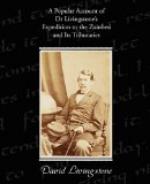Another chief, who died a number of years ago, believed that he had discovered a remedy for tsetse-bitten cattle; his son Moyara showed us a plant, which was new to our botanist, and likewise told us how the medicine was prepared; the bark of the root, and, what might please our homoeopathic friends, a dozen of the tsetse are dried, and ground together into a fine powder. This mixture is administered internally; and the cattle are fumigated by burning under them the rest of the plant collected. The treatment must be continued for weeks, whenever the symptoms of poison appear. This medicine, he frankly admitted, would not cure all the bitten cattle. “For,” said he, “cattle, and men too, die in spite of medicine; but should a herd by accident stray into a tsetse district and be bitten, by this medicine of my father, Kampa-kampa, some of them could be saved, while, without it, all would inevitably die.” He stipulated that we were not to show the medicine to other people, and if ever we needed it in this region we must employ him; but if we were far off we might make it ourselves; and when we saw it cure the cattle think of him, and send him a present.
Our men made it known everywhere that we wished the tribes to live in peace, and would use our influence to induce Sekeletu to prevent the Batoka of Moshobotwane and the Makololo under-chiefs making forays into their country: they had already suffered severely, and their remonstrances with their countryman, Moshobotwane, evoked only the answer, “The Makololo have given me a spear; why should I not use it?” He, indeed, it was who, being remarkably swift of foot, first guided the Makololo in their conquest of the country. In the character of peacemakers, therefore, we experienced abundant hospitality; and, from the Kafue to the Falls, none of our party was allowed to suffer hunger. The natives sent to our sleeping-places generous presents of the finest white meal, and fat capons to give it a relish, great pots of beer to comfort our hearts, together with pumpkins, beans, and tobacco, so that we “should sleep neither hungry nor thirsty.”
In travelling from the Kafue to the Zungwe we frequently passed several villages in the course of a day’s march. In the evening came deputies from the villages, at which we could not stay to sleep, with liberal presents of food. It would have pained them to have allowed strangers to pass without partaking of their hospitality; repeatedly were we hailed from huts, and asked to wait a moment and drink a little of the beer, which was brought with alacrity. Our march resembled a triumphant procession. We entered and left every village amidst the cheers of its inhabitants; the men clapping their hands, and the women lullilooing, with the shrill call, “Let us sleep,” or “Peace.” Passing through a hamlet one day, our guide called to the people, “Why do you not clap your hands and salute when you see men who are wishing to bring peace




